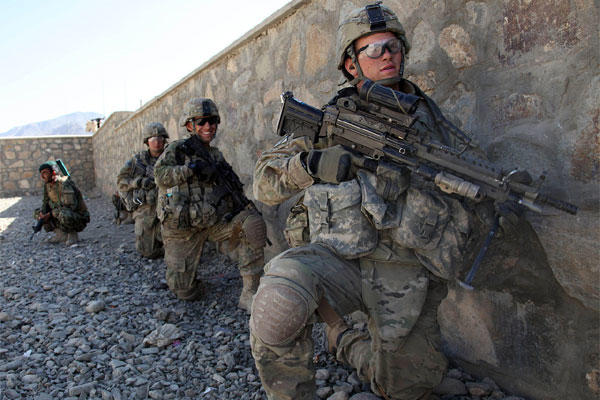The U.S. has increased airstrikes against the Islamic State in eastern Afghanistan while preparing to send hundreds of 10th Mountain Division troops into southwestern Helmand province on a "force protection" mission to shore up an Afghan Army Corps battered by the Taliban, a U.S. military spokesman said Thursday.
In the last three weeks, American F-16 fighter jets have "significantly increased pressure and the number of strikes" in eastern Nangarhar province bordering Pakistan, where fighters pledging allegiance to the Islamic State of Iraq and Syria, or ISIS, were believed to number 1,000-3,000, said Army Brig. Gen. Wilson Shoffner, chief spokesman for U.S. Forces-Afghanistan.
In a video briefing from Kabul to the Pentagon, Shoffner declined to say how many U.S. airstrikes were conducted in Nangarhar but cited the lack of operational fixed-wing aircraft in the Afghan Air Force for ground attack.
In January, the U.S. sent the first four of 20 Brazilian-made A-29 Super Tucano turboprop ground attack planes to Afghanistan but the struggling Afghan Air Force will probably not be able to put them to use until the summer, Shoffner said.
One reason was the lack of Afghan tactical air controllers to guide the A-29s to targets, Shoffner said. Currently, there are a total of about 18 TACs in the entire Afghan National Security Forces of 352,000, he said.
"The A-29s should be coming into operational status this summer," he said, but "We've got to have TACs on the ground, we've got to know where they can't strike" to avoid civilian casualties. "That's one of the key challenges."
The stepped up airstrikes against ISIS came about under loosened rules of engagement authorized by President Barack Obama in December to allow targeting of the terror group.
The Taliban currently are excluded under the rules of engagement. "We don't have targeting authority to target the Taliban and we don't," except in self-defense when U.S. troops come under attack, Shoffner said.
ISIS announced its presence in Afghanistan in January 2015 and is now seen by the U.S. as "operationally emergent" and seeking to set up a base in Nangarhar while failing to attract recruits in other areas, Shoffner said.
"We are seeing (ISIS) attempting to do low-level recruiting and propaganda in various places," he said. "Almost all of those with the exception of Nangarhar province in the east are unsuccessful. So, very, very low level activity with the exception of the east. And in the east, in Nangarhar province, we are seeing (ISIS) attempting to establish a base of operations there."
Many of those drawn to ISIS were believed to be "rebranded" Taliban from the Tehrik-e-Taliban Pakistan, or Pakistani Taliban group which operates on both sides of the border, Shoffner said.
"In terms of motivation, what we see are generally former TTP who believe that associating with Daesh or pledging to Daesh will further their interests in some way," he said, referring to another term for ISIS.
In Helmand and elsewhere, the relatively mild winter weather in Afghanistan has been a factor in the resurgence of the Taliban, as light snowfalls have kept open mountain pass re-supply routes from Pakistan, Shoffner said. "The mild weather has worked to their advantage," he said.
The Taliban began major offensives in Helmand last October and the counter-offensive by the Afghan National Army's 215th Corps that started in November has struggled to gain momentum as leaders were sacked and troops deserted.
The plight of the 215th Corps was underlined by the Taliban attack near Marjah, which U.S. Marines took in a major campaign in 2010. A U.S. Special Forces team training and advising the 215th became involved in an hours-long firefight and Sgt. 1st Class Matthew McClintock was killed.
The additional U.S. troops being sent in the coming weeks into Helmand would mainly be assigned to a force protection mission for the U.S. trainers and advisors already there, Shoffner said. The troops would come from the 500 from the 2nd Battalion, 87th Regiment, 10th Mountain Division, based at Fort Drum, New York.
The 500 were on a routine rotation to switch out with an equal number of U.S. troops in Afghanistan and they will not boost the current U.S. troop level in Afghanistan of about 9,800.
The 10th Mountain troops had originally been scheduled to be based at Bagram airfield north of Kabul but many of them -- Shoffner would not say how many -- will now be sent to Helmand.
"Some elements of that battalion will be in Helmand," he said, to help in rebuilding the 215th Corps and they will stay there "until that Corps is combat ready." The general stressed that the U.S. troops would not be involved in combat operations.
The problems experienced by the 215th Corps extended through the entire Afghan National Army and typified the major changes that were needed in leadership and training to improve readiness even after 14 years of training, advising and assisting by the U.S., Shoffner said.
He said 92 Afghan generals recently were fired, including the leader of the 215th Crops who was ousted because of corruption, but "in some cases they put a guy in who turns out not to be the right leader."
The Afghan forces also have yet to get into what Shoffner called a "force readiness cycle" of training, combat operations and then reset. As a result, "Some of their forces are worn down," he said.
Note: This story was updated to correct the spelling of the general's first name in the second paragraph.
-- Richard Sisk can be reached at Richard.Sisk@Military.com





























